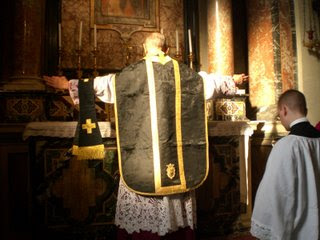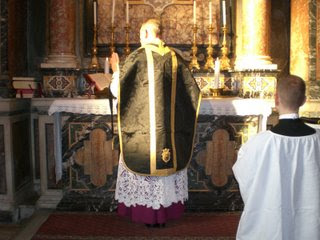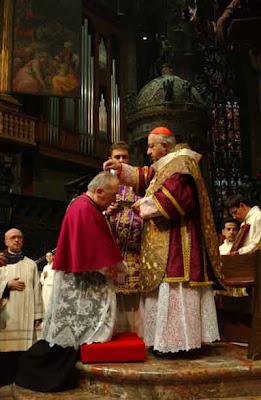This article by our Ambrosian expert Nicola de’ Grandi was originally published on NLM on March 23, 2010. From time to time, we will be reposting earlier articles which may be of interest to our newer readers.
![]()
According to the Ambrosian liturgical tradition, this present week is the last week of the ordinary Lenten season, before the beginning of the season “in Authentica”, known as Holy Week in the Roman Rite. In fact, there is no Passiontide in the Ambrosian Rite, and Crucifixes in Ambrosian churches are never veiled.
This shift gives an occasion to give our readership some information about the use of liturgical colours during Lent in the Ambrosian Rite.
First of all, it should be noted that in the Ambrosian Tradition, the whole of Lenten time is “aeortological”, that is no Saint’s feast - apart from St. Joseph and the Annunciation, the latter only since 1902 - is ever celebrated during Lent. Thus, almost on every Lenten weekday, the Mass is de feria, with the only exception of the above mentioned feasts. Fridays are always aliturgical, and the celebration of the Mass in Ambrosian churches is strictly, as is the celebration of Mass by Ambrosian priests in the Roman Rite churches of the diocese.
The liturgical colour for Lenten feriae is that of strict penance: black.
![]()
In fact, according to the Ambrosian tradition, black is not only the colour of mourning (and, as such, used for requiem Masses), but also the true color of penance and fast. In this sense it is used at least since the 12th century not only for Lenten ferial days, but also for the Minor Litanies, which in the Ambrosian Rite occur after the Ascension, not before.
![]()
It is also worth noting that the use of black for Lenten feriae has been recently restored as an option in the Ordinary Form.
On Sundays, on the contrary, when penance is partially mitigated and the fast is suspended, the colour used for liturgy is -or rather should be- a dark sort of violet called “morello”, which is very different form the Roman “violaceo”.
You see an example of this difference in the photo below, taken during a Pontifical Mass in the Cathedral; the Archbishop of Milan is wearing morello vestments, while the deacon is wearing a roman violet dalmatic. (The imposition of the ashes takes place at the beginning of Lent only in the Ordinary Form.)
![]()
Rose-colored vestments are never used in the Ambrosian tradition.
The use of black and morello ends with the Thursday after the Fifth Sunday of Lent; the following Friday is, of course, aliturgical.
The Saturday after the Fifth Sunday of Lent is called “in Traditione Symboli - at the handing down of the Creed”, the day on which the Creed was imparted to the catechumen. From this day forward, the Ambrosian Church drops black and wears only red during the whole week “in Authentica”, even on Maundy Thursday and Good Friday, until Easter Eve.
During the Easter Vigil, which has structure very different from the Roman one, the celebrant and major ministers will drop red and wear white, which is used only the Saturday “in albis”.
On the Sunday immediately afterwards, called “Dominica in Albis depositis”, as the neophytes put aside the white dress they received during the Paschal Vigil, so also for liturgical cermonies, white is replaced with green, which will be used for the rest of Eastertide.
This shift gives an occasion to give our readership some information about the use of liturgical colours during Lent in the Ambrosian Rite.
First of all, it should be noted that in the Ambrosian Tradition, the whole of Lenten time is “aeortological”, that is no Saint’s feast - apart from St. Joseph and the Annunciation, the latter only since 1902 - is ever celebrated during Lent. Thus, almost on every Lenten weekday, the Mass is de feria, with the only exception of the above mentioned feasts. Fridays are always aliturgical, and the celebration of the Mass in Ambrosian churches is strictly, as is the celebration of Mass by Ambrosian priests in the Roman Rite churches of the diocese.
The liturgical colour for Lenten feriae is that of strict penance: black.

In fact, according to the Ambrosian tradition, black is not only the colour of mourning (and, as such, used for requiem Masses), but also the true color of penance and fast. In this sense it is used at least since the 12th century not only for Lenten ferial days, but also for the Minor Litanies, which in the Ambrosian Rite occur after the Ascension, not before.

It is also worth noting that the use of black for Lenten feriae has been recently restored as an option in the Ordinary Form.
On Sundays, on the contrary, when penance is partially mitigated and the fast is suspended, the colour used for liturgy is -or rather should be- a dark sort of violet called “morello”, which is very different form the Roman “violaceo”.
You see an example of this difference in the photo below, taken during a Pontifical Mass in the Cathedral; the Archbishop of Milan is wearing morello vestments, while the deacon is wearing a roman violet dalmatic. (The imposition of the ashes takes place at the beginning of Lent only in the Ordinary Form.)

Rose-colored vestments are never used in the Ambrosian tradition.
The use of black and morello ends with the Thursday after the Fifth Sunday of Lent; the following Friday is, of course, aliturgical.
The Saturday after the Fifth Sunday of Lent is called “in Traditione Symboli - at the handing down of the Creed”, the day on which the Creed was imparted to the catechumen. From this day forward, the Ambrosian Church drops black and wears only red during the whole week “in Authentica”, even on Maundy Thursday and Good Friday, until Easter Eve.
During the Easter Vigil, which has structure very different from the Roman one, the celebrant and major ministers will drop red and wear white, which is used only the Saturday “in albis”.
On the Sunday immediately afterwards, called “Dominica in Albis depositis”, as the neophytes put aside the white dress they received during the Paschal Vigil, so also for liturgical cermonies, white is replaced with green, which will be used for the rest of Eastertide.

